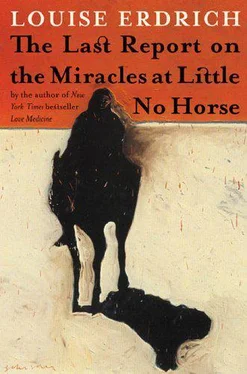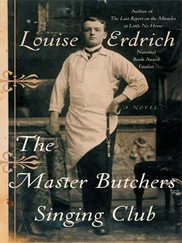Snow as fine as smoke blew in as she entered the church, but the nuns did not move. They knelt, hunched in cold, swathed in layers of patched wool, quiet as stones. There was only one parishioner in attendance, and in spite of the extremity of the cold and the tension of her first test in saying Mass, Agnes noticed her. The girl seemed, in her stiffness, to creak as she turned to watch. She stared as Father Damien walked to the nave of the church.
The girl’s nose jutted, her face was white and beak-thin, and her mouth was shaped by birth into a pale and twisted line. She stared at the priest with great, starved, black, disturbing eyes. Stared unblinking and with fixed aggressiveness. Young and scrawny as a new bird, she opened her mouth as though to shout, then shut it as Father Damien put out his hands to the women, the sisters, and held their hands and greeted them — the sight of their resigned and exhausted faces washed over him with a familiar tenderness.
“My dear sisters in Christ, my dear, dear sisters…”
They rose in surprise. Apparently, Father Damien wasn’t expected to arrive — thus the terrible disorder of the cabin. Their faces, gazing dull, were the maws of starved animals and their fingers were limp as wilted stalks. By the shape of their skulls, the wrinkled hands of privation, it was easy to see death was poking through their very skins. For the first time, now, Agnes was afraid, for she knew that the food she had eaten back in the convent was absolutely all they had.
“Let us pray,” Father Damien’s voice squeaked. Agnes tried to control the shaking and keep her voice low, but her tongue was thick with cold despair. She remembered to venerate the relic in the altar — what was it: splinters from the true cross? a filing from St. Peter’s manacles? perhaps a bit of bone, a slice of skin, a toe, an ear? What saint? How would she find out or ever know? It was the priest’s job to know. There was no altar boy, no vestments, and the chalice was humble pewter, but when Father Damien opened the sacristy and found fourteen holy wafers and a thread of wine, he turned in elation to the sisters.
“We have no choir”—he was already half delirious again with hunger—“but we will raise our best hymn! Body of Christ, blood of Christ, same here as in the richest cathedral. This is our cloth-of-gold.” He touched the burlap weave of the mantle, laid out on the altar stone. “This is our pearl-studded gospel.” He lovingly stroked the rag-bound book. “Our incense is God’s own breath — the wind through these rough walls!”
The women sighed together, all except for the one parishioner, the seething girl in a black scarf. She laughed out loud, screeched really, then coughed to contain her mirth. The nuns seemed numb to her. They prayed together and a cloud of breath stirred from their lips. Their hands were blistered with cold, their cheeks frostbitten and raw. The priest’s words were brave, but the sisters were at the razor edge of their endurance. They slumped against the wood of the pews, barely managed to hold themselves upright.
At least, now, the fire in the little tin stove had begun to warm the cabin of the church.
The Mass came to Agnes like memorized music. She had only to say the first words and all followed, ordered, instinctive. The phrases were in her and part of her. Once she began, the flow was like the river that had carried her to Little No Horse. In the silences between the parts of the ritual, Father Damien prayed for those women in his charge.
“ Quam oblationem, tu Deus, in omnibus quaesumus, benedictam… ” He crossed his breast five times, within those words, and the next: “ Qui pridie quam pateretur, accepit panem in sanctas ac venerabiles manus suas… ” And lifted his eyes and said the words “ Hoc est enim corpus meum, ” and the bread was flesh.
Of course it was, as it always was.
“ Hic est enim calix sanguinis mei novi et aeterni testamenti: mysterium fedei …” The wine was blood.
And again, as she had before, the strange girl in the front pew emitted a sudden croak of laughter.
On her lips, in her mouth. Real and rich, heavy, good. Agnes choked with startled shock. She hesitated, put the food to her mouth again. Real! Real! Hunger roared in her as she broke the bread. Ate the flesh. Delivering the communion meal to her starving sisters, Agnes was caught in a panic of emotion. She heard nothing, saw nothing, went through the rest of Mass on reeling instinct. Was it really true and had they, as well, experienced what she’d felt? Was this something that happened, always, to priests? Did their part of the sacrament transubstantiate in real as well as metaphorical terms? Had the dry thin consecrated Host turned into a thick mouthful of raw, tender, bloody, sweet-tasting meat in the mouths of the sisters? And the wine to vital blood? And were they all full, as Agnes felt, satisfied and calm? They finished the Mass and stumbled back, holding one another by turns, all except for the black-eyed child, who abruptly left, quite alone, prompting Agnes to ask the nun nearest for the name of this striking person.
“She’s a Puyat,” said the sister. “Her name is Pauline. She is here every morning, most devout, but…” She paused as if to say something more, but only shrugged as though, after all, she was too weak to explain.
Once alone, Agnes went dizzy with questions.
Had Christ’s real presence entered them? Certainly, now, they were saved from the place of skulls, from the bones of death. Were they fed with the fat of the wheat and honey out of the rock? Was this just part of the ritual or was it miraculous?
That night, she composed Father Damien’s first letter.
March 1912
Gracious Leader of the Faith,
I write in humble fearfulness and wonder. To whom else might I turn? I beg you to indulge me, Your Holiness. Please forgive my attempt to explain, though it be insufficient. It is just that to reconstruct, to go back, to establish the scene requires at present a spiritual energy I cannot summon. I am reeling. I have such questions.
To wit: Have you or your holy minions knowledge of a case in which the transubstantiated body and blood of Christ has in actuality (and I mean physically, not only in a spiritual sense) nourished the flock?
In other words, did the wafer turn into visible meat, the wine to actual blood?
And also, to your understanding, would it be wrong for a cleric to request a visit by the devil, just to make certain of his physical shape?
I await your reply.
SISTER HILDEGARDE’S VIEWS
The Superior, Sister Hildegarde Anne, was a woman of German resourcefulness. Short, boxy, impenetrable, she had saved her sisters, as well as many others, early on that winter by ordering the church horse butchered while it still had flesh, and distributing its store of oats and grain. She had a toughness of expression unusual in a nun, and spoke bluntly. Also, she was effortlessly cheerful in a way that often outraged or frightened other people. Now, for instance, as she spoke to Father Damien in the intimacy of the kitchen, she shaved the last of that poor beast’s hooves into a pot of boiling soup water. As she worked, she hummed and then sang out, trimming the great rocky chunk of chitin with a sharp filet knife. Beside the soup pot, half a precious potato soaked in salted water. The sparsity didn’t seem to bother her. Someone had left six other potatoes and a rind of bacon, held now under lock and key. All of this would keep the religious band alive today, and today, she said, was as far as she ever went in her prayers.
Although Agnes felt what she felt, believed what she believed, about what had happened during the Eucharist, the two exchanged no more than a significant sentence. Agnes was to find that Sister Hildegarde was of such deeply skeptical stock that she did not entirely accept her own experience as true. Hildegarde’s concerns were down-to-earth. Since she was on the reservation to be useful, she lost no time in telling Father Damien how he could make himself useful too.
Читать дальше












